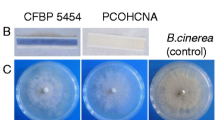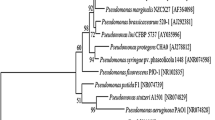Abstract
Biosynthesis and secretion of two different types of antifungal compound [phenazine-1-carboxylic acid (PCA) and pyoluteorin (Plt) in Pseudomonas sp. M18] contribute to its suppression of soil-borne root pathogens. To better understand the correlation between two antifungal agents in secondary metabolism, a DNA fragment covering partial pltC and pltD coding sequences was obtained by screening the genomic library of Pseudomonas sp. M18. A mutant, M18T, was then constructed by insertion of the aacC1 gene cassette (encoding gentamycin resistance). With the same methods, one PCA biosynthetic gene cluster was insertionally inactivated and a mutant M18Z1 was created. The mutant strain M18T produces no Plt and the same amount of PCA in comparison with the wild-type strain M18. The mutant M18Z1, however, produces less PCA but more Plt than the wild-type strain M18. According to the documented data on strain M18, it is suggested that production of PCA is not influenced by Plt yield, but Plt biosynthesis is influenced by an alteration of PCA production.


Similar content being viewed by others
Literature Cited
Baehler E, Bottiglieri M, Pechy-Tarr M, Maurhofer M, Keel C (2005) Use of green fluorescent protein-based reporters to monitor balanced production of antifungal compounds in the biocontrol agent Pseudomonas fluorescens CHA0. J Appl Microbiol 99(1):24–38
Blumer C, Heeb S, Pessi G, Haas D (1999) Global GacA steered control of cyanide and exprotease production in Pseudomonas fluorescens involves specific ribosome binding sites. Proc Natl Acad Sci USA 96:14073–14078
Chancey ST, Wood DW, Pierson LS III (1999) Two-component transcriptional regulation of N-acyl-homoserine lactone production in Pseudomonas aureofaciens. Appl Environ Microbiol 65:2294–2299
Chen WP, Kuo TT (1993) A simple and rapid method for the preparation of Gram-negative genomic DNA. Nucleic Acids Res 21:2260–2261
De Lorenzo V, Timmis KN (1994) Analysis and construction of stable phenotypes in Gram-gegative bacteria with Tn5 and Tn10-derived transposons. Methods Enzymol 235:386–405
Del Sal G, Manfioletti G, Schneider C (1988) A one-tube plasmid DNA mini-preparation suitable for sequencing. Nucleic Acids Res 16:9878
Fenton AM, Stephens PM, Crowley J, O’Callaghan M, O’Gara F (1992) Exploitation of gene(s) involved in 2,4-diacetylphloroglucinol biosynthesis to confer a new biocontrol capability to a Pseudomonas strain. Appl Environ Microbiol 58:3873–3878
Ge Y, Huang X, Wang S, Zhang X, Xu Y (2004) Phenazine-1-carboxylic acid is negatively regulated and Plt positively regulated by gacA in Pseudomonas sp. M18. FEMS Microbiol lett 237:41–47
Haas D, Keel C (2003) Regulation of antibiotic production in root-colonizing and relevance for biological control of plant disease. Annu Rev Phytopathol 41:117–153
Heurlier K, Williams F, Heeb S, Dormond C, Pessi G, Singer D, Camara M, Williams P, Haas D (2004) Positive control of swarming, rhamnolipid synthesis, and lipase production by the posttranscriptional RsmA/RsmZ system in Pseudomonas arruginosa PAO1. J Bacteriol 186:2936–2945
Hoang TT, Karkhoff-Schweizer RR, Kutchma AJ, Schweizer HP (1998) A broad-host-range Flp-FRT recombination system for site-specific excision of chromosomally-located DNA sequences: application for isolation of unmarked Pseudomonas aeruginosa mutants. Gene 212:77–86
Howell CR, Stipanovic RD (1980) Suppression of Pythium ultimum induced damping-off of cotton seedlings by Pseudomonas fluorescens and its antibiotic, pyoluteorin. Phytopathology 70:712–715
Hu H, Xu Y, Cheng F, Zhang X (2005) Isolation and characterization of a new fluorescent Pseudomonas strain produced both phenazine 1-carboxylic acid and pyoluteorin. J Microbiol Biotechnol 15(1):86–90
Huang X, Zhu D, Ge Y, Zhang X, Xu Y (2004) Identification and characterization of pltZ, a gene involved in the repression of pyoluteorin biosynthesis in Pseudomonas sp. M18. FEMS Microbiol Lett 232:197–202
Levitch ME, Stadtman ER (1964) A study of the biosynthesis of phenazine-1-carboxylic acid. Arch Biochem Biophys 106:194–199
Lugtenberg BJJ, Dekkers L, Bloemberg GV (2001) Molecular determinants of rhizosphere colonization by Pseudomonas. Annu Rev Phytopathol 39:461–490
Keel C, Schnider U, Maurhofer M, et al. (1992) Suppression of root diseases by Pseudomonas fluorescens CHA0: importance of the bacterial secondary metabolite 2, 4-diacetylphloroglucinol. Mol Plant Microbe Interact 5:4–13
Khan SR, Mavrodi DV, Jog GJ, Suga H, Thomashow LS, Farrand SK (2005) Activation of the phz operon of Pseudomonas fluorescens 2–79 requires the LuxR homolog PhzR, N-(3-OH-hexanoyl)-L-homoserine lactone produced by the LuxI homolog PhzI, and a cis-acting phz box. J Bacteriol 187:6517–6527
King EO, Ward MK, Raney DE (1954) Two simple media for the demonstration of pyocyanin and fluorescin. J Lab Clin Med 44:301–307
Maurhofer M, Keel C, Haas D, Défago G (1994) Pyoluteorin production by Pseudomonas fluorescens strain CHA0 is involved in the suppression of Pythium damping-off of cress but not of cucumber. Eur J Plant Pathol 100:221–232
Mavrodi DV, Bonsall RF, Delaney SM, Soule MJ, Phillips G, Thomashow LS (2001) Functional analysis of genes for biosynthesis of pyocyanin and phenazine-1-carboxamide from Pseudomonas aeruginosa PAO1. J Bacteriol 183:6454–6465
Nowak-Thompson B, Chaney N, Wing JS, Gould SJ, Loper JE (1999) Characterization of the pyoluteorin biosynthetic gene cluster of Pseudomonas fluorescens Pf-5. J Bacteriol 181:2166–2174
Pierson LS III, Gaffney T, Lam S, Gong F (1995) Molecular analysis of genes encoding phenazine biosynthesis in the biological control bacterium Pseudomonas arueofaciens 30–84. FEMS Microbiol Lett 134:299–307
Raaijmakers JM, Vlami M, de Souza JT (2002) Antibiotic production by bacterial biocontrol agents. Antonie van Leeuwenhoek 81:537–547
Sambrook J, Russell DW (2001) Molecular cloning: A laboratory manual. 3rd ed. Cold Spring Harbor Laboratory Press, Cold Spring harbor, NY
Schnider-Keel U, Seematter A, Maurhofer M, et al. (2000) Autoinduction of 2,4-diacetylphloroglucinol biosynthesis in the biocontrol agent Pseudomonas fluorescens CHA0 and repression by the bacterial metabolites salicylate and pyoluteorin. J Bacteriol 182:1215–1225
Schweizer HD (1993) Small broad-host-range gentamicin resistance gene cassettes for site-specific insertion and deletion mutagenesis. Biotechniques 15:831–834
Smith AW, Iglewski BH (1989) Transformation of Pseudomonas aeruginosa by electroporation. Nucleic Acids Res 17:10,509
Short JM, Fernandez JM, Sorge JA, Huse WD (1988) Lambda ZAP: a bacteriophage lambda expression vector with in vivo excision properties. Nucleic Acids Res 16:7583–7600
Thomashow LS (1996) Biological control of plant root pathogen. Curr Opin Biotechnol 7:343–347
Thomashow LS, Weller DM (1988) Role of a phenazine antibiotic from Pseudomonas fluorescens in biological control of Gaeumannomyces graminis var. tritici. J Bacteriol 170:3499–3508
Voisard C, Keel C, Haas D, Défago G (1989) Cyanide production by Pseudomonas fluorescens helps suppress black root rot of tobacco under gnotobiotic conditions. EMBO J 8:351–358
Whistler CA, Corbell NA, Sarniguet A, Ream W, Loper JE (1998) The two-component regulators GacS and GacA influence accumulation of the stationary-phase sigma factor S and the stress response in Pseudomonas fluorescens Pf-5. J Bacteriol 180:6635–6641
Weller DM, Cook RJ (1983) Suppression of take-all of wheat by seed treatments with fluorescent pseudomonads. Phytopathology 73:463–469
Acknowledgments
We thank Dr. Stephan Heeb for kindly providing the plasmids used in this study. This work was financially supported by grant No.30370041 from the National Science Foundation.
Author information
Authors and Affiliations
Corresponding author
Rights and permissions
About this article
Cite this article
Ge, YH., Pei, DL., Zhao, YH. et al. Correlation Between Antifungal Agent Phenazine-1-Carboxylic Acid and Pyoluteorin Biosynthesis in Pseudomonas sp. M18. Curr Microbiol 54, 277–281 (2007). https://doi.org/10.1007/s00284-006-0317-x
Received:
Accepted:
Published:
Issue Date:
DOI: https://doi.org/10.1007/s00284-006-0317-x




